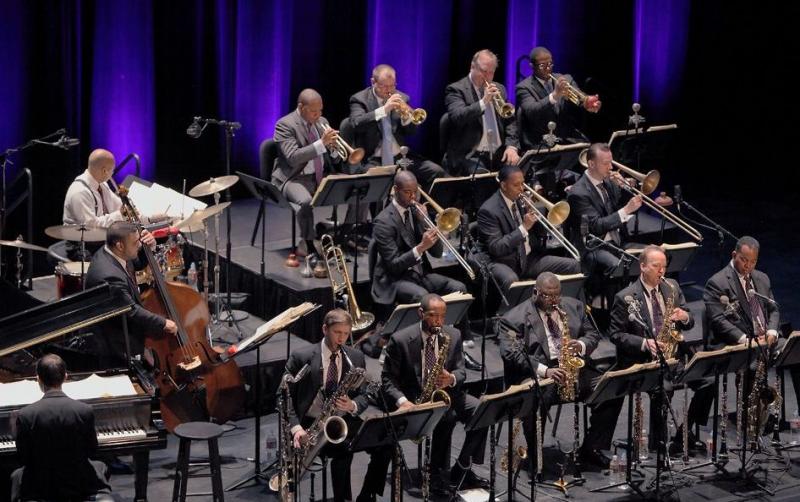The Jazz at Lincoln Center Orchestra
By Marilyn Lester
There are certain events so extraordinary that years later folks ask, “Were you there that night?” This is one of them. The Jazz at Lincoln Center Orchestra’s Benny Goodman: The King of Swing went beyond its tribute to Goodman’s historic 1938 concert at Carnegie Hall by making its own show a night to remember. The genius of its execution was not in recreating the original note for note, but in conceptual excellence shadowing that January night in 1938, especially in amassing some of the world’s greatest clarinetists – reed stars Anat Cohen, Ken Peplowski and Janelle Reichman, joining JALCO’s own Victor Goines and Ted Nash.
Goines abandoned his chair in the bandstand to take on music direction and onstage leadership. Among the backstories told, the significance of the Carnegie Hall event was foremost. Goodman’s extravaganza put America’s own music – jazz – on the map. With his integrated roster of stars, Goodman elevated and legitimized jazz as a respectable cultural genre. Even that great giant, Duke Ellington, wasn’t able to do that. (It took six more years for Ellington to make his own Carnegie Hall debut.) The evening’s opener was Goodman’s (with Edgar Sampson) “Don’t Be That Way.” The swinging arrangement was a departure for JALCO, which largely plays its own Ellington-based style. In this case, over half the numbers on the program were arranged by Goodman’s man, Bob Wilber. As always, the band played in a tight groove, easily mastering the Goodman ethic.
The parade of guest artists in Benny Goodman: The King of Swing constituted a dizzying smorgasbord of prime musical talent. In addition to the aforementioned clarinetists, the roster included vibraphonist Joseph Doubleday, a magical player standing in for the original – Lionel Hampton. His “I’ve Got Rhythm,” with Reichman, plus Dan Nimmer’s piano and Marion Felder’s drums, was a thrilling jazz train ride, speeding down the tracks of swing. Reichman and Doubleday also delivered a craftily improvisational “Stompin’ at the Savoy.” Doubleday’s feature on the jazz classic “Avalon,” with Goines on clarinet, was another uptempo showcase of mutual virtuosity. The small combo was a feature of the original concert, and in this tribute, Nimmer and Felder earned a welcome position in the spotlight, mirroring 1938 counterparts Teddy Wilson and Gene Krupa.
Anat Cohen, arguably among the very finest clarinet players in the world, exuded soulful playing and superb dexterity on “China Boy” and “One O’clock Jump.” Peplowski offered a swinging early Richard Rodgers tune, “Blue Room,” as well as a big, fulsome swing “Dizzy Spells” with Doubleday’s vibes. Martha Tilton was the girl singer with Goodman’s band at Carnegie Hall. Her stand in was Veronica Swift, who herself may well go down in history. At age 23 she’s already a seasoned performer with chops that may eventually put her on a par with Ella Fitzgerald and Sarah Vaughan. She’s that good. Her renditions of the traditional Scottish song “Loch Lomond” and the Yiddish “Bei Mir Bist Du Schon” displayed Swift’s innate, soulful feeling for jazz, mellow voice and impeccable phrasing.
A major feature of Goodman’s groundbreaking concert was its forceful recognition of his brethren of color, Duke Ellington and Count Basie. The “Twenty Years of Jazz” segment featured stars of the Duke Ellington and Count Basie orchestras, including Ellington’s Cootie Williams (tr), Harry Carney (bar. sax) and Johnny Hodges (alto sax); plus Count Basie with his men, Buck Clayton (tr), Bobby Hackett (cor), Lester Young (ten. sax), Walter Page (bass) and Freddie Green (guitar). These icons were represented in several band numbers, with solos by JALCO members. JALCO also played Goodman’s tribute to the Duke, Ellington’s composition (with Harry Carney) of “Blue Reverie,” as well as Fletcher Henderson’s arrangement of Berlin’s “Blue Skies,” with its Ellington style of play.
The crowning glory of Benny Goodman: The King of Swing was a “killer diller” finale of Louis Prima’s hard-driving jazz classic, “Sing, Sing, Sing.” Featuring a wall of five clarinets, plus Doubleday on vibes, the joint was jumping with an energy that could have lifted the roof off the house. Among the many solos proffered, drummer Felder stole the show with a virtuosity that might have awoken Krupa from his eternal rest. Happily, unlike the Goodman concert, where all recordings were presumed lost until a fluke turned up an acetate in 1950, this one is already preserved for posterity – proof of its legendary status to come.
The Jazz at Lincoln Center Orchestra, Benny Goodman: The King of Swing, Rose Theater, January 10, 11 and 12, 2018 at 8 pm
Jazz at Lincoln Center, Broadway at 60th Street, 212-721-6500, www.jazz.org






















